
|
A GOOD SPECTROSCOPE BY JOHN BROWNING, LONDON, CIRCA 1875
in lacquered and oxidised brass, signed by the prism John Browning, 63 Strand, London, circumference scale divided 0-110 with vernier and magnifier, 13in. observation tube with rack-and-pinion fine focus, secondary tube with crystal sample, mounted on tapering brass pillar to painted iron stand secured to sliding base board to fit case with ivorine retailer's label for Clarkson's, High Holborn, London, the case - 15½ x 9½in. (39.5 x 24cm.)
£300-400
|
|
 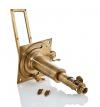 |
A LACQUERED BRASS SOLAR MICROSCOPE, PROBABLY
19TH-CENTURY
unsigned, with 6½in. main tube with rack-and-pinion focus by slide assembly, mounted to back plate with vertical and horizontal key-turn mirror orientation - the back plate - 4¾in. (12cm.) square
£250-350
|
|

|
A DIDACTIC PRISM AFTER AHREN BY NEWTON & CO., LONDON CIRCA 1890
the lacquered brass prism signed as per title and mounted on a mahogany board, the sliding optical components with rack and pinion fine adjustment, - 31in (79cm.) overall length
£1000-1500
|
|

|
A 19TH-CENTURY LACQUERED BRASS CULPEPER-TYPE MICROSCOPE
unsigned, the 5½in. barrel with rack-and-pinion focusing and tube focus lines, contained within fitted pyramid case with drawer containing accessories including four numbered nosepieces, live box, fish plate and blank four-aperture bone slide, the case - 12¾in. (32.5cm.) high
£200-300
|
|

|
FOUR 19TH-CENTURY TOY MICROSCOPES
all unsigned, comprising Nuremberg tripod and drum-types; a screw-barrel type after Eustachio Divini; and a scioptic ball, the tallest - 12in. (30.5cm.) high
(4)
£100-150
|
|

|
A FINE COLLECTION OF PREPARED MICROSCOPE SLIDES,
19TH-CENTURY
comprising approx. 1,000 slides with most professionally prepared by houses including Baker; Ross; Peal; Smith; Beck & Beck; Adlington; Frederick Wood; etc., each slide with manuscript description and contained within three compartment fitted drawer in two collectors' cabinets, one with maker's plate for W. Watson & Sons London, Watson cabinet - 13 x 10½ x 11¾in. (33 x 26.5 x 30cm.)
(2)
£1500-2500
|
|

|
A LATE 19TH-CENTURY MICROSCOPE SLIDE PREPARATION SET
unsigned, with drop-down front revealing fitted compartments and drawers containing apparatus, tools, spare labels, glasses etc. as appropriate - 13½in. (34cm.) wide; together with two enclosed glass slide drying dishes with fitted interiors
(3)
£150-250
|
|

|
Ø A GROUP OF OPTICAL INSTRUMENTS
comprising an Adams type gilt brass and turned ivory monocular by Watkins & Hill, London, a small monocular spyglass by L. Cassella, London, two map readers, a folding lacquered brass pocket magnifier, and four modern pocket microcopes
(9)
£150-250
|
|

|
Ø A WITHERING FIRST-TYPE POCKET MICROSCOPE, CIRCA 1776
of standard form with brass-handled accessories comprising diamond-headed scalpel, pricket and tweezers, contained within original cylindrical card case of issue - 4½in. (11.5cm.) high; together with a second-type Withering folding pocket microscope of usual form, with pasted label inside lid annotated A Gift from Lady Archer, 1799, the case with accessories including additional lens, tweezers, scalpel, and two four-aperture bone slides with samples - 4¾in. (12cm.) wide
(2)
£250-350
|
|

|
A POCKET MICROSCOPE, PROBABLY LATE 19TH-CENTURY
unsigned, of miniature conventional form, folding into plush-lined card case - 5in. (12.5cm.) wide; together with another pocket microscope, a mid-19th-century brass simple microscope; and a fleaglass with bulbous glass body and removable base
(4)
£150-250
|
|

|
Ø A 19TH-CENTURY JONES-TYPE POCKET NATURALIST'S MAGNIFIER
unsigned, in lacquered brass with folding turned ivory handle and lens, the specimen slider with reversible pin/pincer, contained in card pocket case - 2¾in. (7cm.) wide; together with another of similar type, mid-19th-century, the case 6¼in. (16cm.) wide.
(2)
£200-300
|
|

|
A BOTANIST'S MICROSCOPE BY CARPENTER, LONDON, CIRCA 1830
of typical form, signed on the rack-and-pinion mounting post Carpenter, 24 Regent Str.t, London, contained within fitted box with accessories including four nose-pieces, platform pincer, five four-aperture bone slides with samples, plush-lined lid and securing hooks - 6½in. (16.5cm.) wide
Philip Carpenter (w.1808-d.1833) occupied this Regent's Street address between 1827 and 1833
£300-400
|
|

|
A GOOD BOTANIST'S MICROSCOPE BY G. & C. DIXEY, LONDON, CIRCA 1830
signed on the lacquered brass limb G. & C. Dixey, New Bond Street, LONDON, contained in a tray within fitted plush case complete with accessories including four nosepieces, a live box and two six-aperture bone slides with specimens - 5½ x 4½in. (14 x 11.5cm.)
Provenance: Sotheby's, 7th February 1972
£400-600
|
|

|
AN EARLY 19TH-CENTURY LACQUERED BRASS CARY-TYPE BOTANIST'S POCKET MICROSCOPE
unsigned, of typical form and contained in original fitted case complete with accessories including three nosepieces, live box, tweezers, pricker, scalpel and three bone slides - 4in. (10cm.) diam
£200-300
|
|

|
A 'JONES'S MOST IMPROVED'-TYPE MICROSCOPE MAGAZINE, CIRCA 1820
unsigned, of typical form, contained within fitted case with accessories including four nose-piece, reflector, live box and a small quantity of four-aperture bone slides wrapped in paper, the box with plush lined lid - 9½in. (24cm.) wide
£400-600
|
|

|
A 19TH-CENTURY DRUM-TYPE MICROSCOPE
unsigned, of typical form and contained in fitted box complete with accessories including six nosepieces, live box, Lieberkühn reflector, platform pincers, tweezers, three four-aperture bone slides etc., the box - 11in. (28cm.) diam
£150-250
|
|

|
A LATE 19TH-CENTURY LACQUERED BRASS MONOCULAR MICROSCOPE AND ACCESSORIES
unsigned, contained in small case with accessories including two nosepieces, alternative eyepiece, bull's eye lens, platform specimen holder, the lower drawer containing a selection of card and glass slides, cased measurement - 10 x 6¼in. (25.5 x 16cm.); together with a brass microscope oil lamp signed on the foot Swift & Son, with counter-signed porcelain shade - 11in. (28cm.) high
(2)
£150-250
|
|

|
A MICROSCOPE LAMP BY R. & J. BECK, LONDON
with lacquered brass ring base signed as per title, burner assembly with adjustable bull's eye lens with glass filter option on chimney, mounted on a quick-release clamp to square-section pillar - 12in. (30.5cm.) high
£100-150
|
|

|
A FINE LACQUERED BRASS MONOCULAR MICROSCOPE BY WRAY, LONDON, CIRCA 1870
with rack-and-pinion adjustment to tube and platforms, contained in fitted case with accessories including four eyepieces, seven nosepieces for 3in.; two 2in.; two 1in.; 2/3in.; ½in.; ¼in. and 1/12in. powers; prism, bull's eye condensing lens and others, contained in fitted mahogany case with additional loose accessories including an early electric lamp and a reflector attachment - 22 x 12¾in. (56 x 32.5cm.); together with an associated part-filled magazine of prepared slides; a box of blank slides, glasses and papers, an empty magazine and a copy of Lionel Beale's How to Work the Microscope, London, 1867
(5)
£2500-4000
|
|
| |
A BINOCULAR TRUNK-TYPE MICROSCOPE BY R. & J. BECK, LONDON, CIRCA 1900
with lacquered and oxidised brass bedplate with hinged support signed on the back as per title and numbered 4994, platform with dual-adjusting knobs, filters, mirror, and rack-and-pinion focusing, together with a fitted tray of accessories including 1/8in.; ¼in.; 1in.; 2in. and 3in. nosepieces, alternative eyepieces, platform filters, bull's eye lens, etc., (lacking case) assembled height - 15in. (38cm.)
(2)
£250-350
|
|

|
A MONOCULAR TRUNK-TYPE MICROSCOPE BY R. & J. BECK, LONDON
in lacquered and oxidised brass, signed as per title and numbered 7698 on the back of the folding stand, contained in fitted box with accessories including five nosepieces, live box, alternative platform, bull's eye lens, and a selection of slides etc., the box - 16in. (40.5cm.) diameter
£200-400
|
|

|
A LACQUERED BRASS MONOCULAR MICROSCOPE BY MORITZ PILLISCHER, LONDON, CIRCA 1859
signed and numbered on the foot M. Pillischer, London, No. 478, 8in. main tube, contained in fitted box with accessories including ¼in.; ½in.; 1in. and 2in. nosepieces, the ½in. dated for 1859, alternative eyepieces, live box, specimen clamp and selection of slides, the box - 16¾ x 7½in. (42.5 x 19cm.)
£500-800
|
|

|
A LATE 19TH-CENTURY MONOCULAR MICROSCOPE BY ARONSBERG & SON, MANCHESTER
with lacquered brass barrel and support and oxidised brass foot signed as per title, contained within a fitted case with fittings and accessories including a ¼in. nosepiece, bull's eye condensing lens and slide drawer - 14½ x 8¾in. (37 x 22cm.)
£300-500
|
|
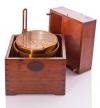 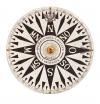  |
A RARE IMPERIAL RUSSIAN NAVAL SIGHTING COMPASS BY SAMOILOV, PRIGIIGIORSK, 1853
the 7in. mica-backed card signed and inscribed in Cyrillic, dated 1853 and inscribed in pencil 1278, double-headed eagle with naval crossed anchors at north, the rim edged with silvered brass and divided with reversed Roman numerals, jewelled suspension pivot and sealing wax balancing, mounted on a sprung steel pin within substantial silvered brass bowl with glazed bottom, removable glass top with folding sights (one missing), lacquered brass gimbal mounts within original wooden box with inset handles, securing hooks, brass makers plate and inscribed in ink K.V. No. 50, overall dimensions - 12in. (30.5cm.) square
Andrew V. Samoilov (1790-1871) was born in St. Petersburg to a family of craftsmen. He entered the Admiralty and ran the instrument studio at the Izhora Factories from 1820 until his death, enjoying the right to add his personal mark to his output. He is considered the first and perhaps finest Russian master instrument maker in the first half of the 19th-century. The Izhora Factories, one of the oldest in Russia, were founded in 1722 by decree of Peter the Great and were the nucleus of Russian naval innovation manufacturing everything from forged anchors and anchor chains, stretched copper sheets for sheathing hulls, armor cladding, steam engines and navigational instruments
£800-1200
|
|

|
A fine dent-TYPE BOATS COMPASS pattern 182 BINNACLE compass by kelvin & james white ltd, circa 1912
with 4in. 'Chetwynd's Patent' card in gimballed bowl contained in regulation binnacle housing with clamp, candle, shade slide, instructions in waterproof slip case and pasted inside door stamped 7 Feb 1912, brass temple top with candle lantern, brass top glass cover inscribed with maker's details and swivel handle, shaped base stenciled PATT 182 behind, with lashing rings, overall measurements - 13 x 9 x 9in. (33 x 23 x 23cm.)
In 1890 four compass manufacturers (Dent, Hughes, Lilley & Reynolds) were invited by the Royal Navy to compete for a new design of boat compass. The specifications required the instrument to be capable of handling the vibrations of a steamboat as well as the usual requirements for sailing and pulling boats and the resulting entries were tested aboard H.M.S. Vernon at Portsmouth. The example offered by Dent was the best on all counts and was introduced as BOATS COMPASS PATTERN 20 in 1892. Apart from a reduction in card size (from 7in. to 4in.) in 1907, the pattern (re-designated 182) remained in service until after World War I
£1500-2000
|
|

|
A FINE EARLY 19TH-CENTURY IVORY POCKET COMPASS BY GILBERT & SONS, LONDON
the 1¾in. mica-backed card with jewelled pivot signed Gilbert & Sons, near Ye India House, Londoni, sealing wax balancing, removable brass pin, supporting inner ivory card damping ring and turned, threaded lid - 1½ x 2½in. (4 x 6.4cm.)
£400-600
|
|
 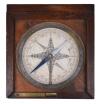 |
A FRENCH SURVEYING COMPASS BY JACQUES CANIVET, CIRCA 1760
with 4in. printed compass rose signed Canivet À Paris by South, half blued-steel needle on jewelled pivot with retainer under, silvered circumference scale, glazed with retaining spring, contained in wooden case counter signed on inset brass plate Canivet à la Sphère à Paris, sliding lid, pivoted side sight and inset table attachments underneath - 6½ x 7in. (16.5 x 18cm.)
Provenance: Sotheby's, 9th June 1977
£300-400
|
|

|
A SMALL WOOD AND BRASS 'SESTREL' YACHT BINNACLE AND COMPASS BY HENRY BROWNE & SON
with 3½in. card signed E. Esdailie & Sons, NSW in liquid-filled bowl gimbal-mounted within brass binnacle with correction spheres, glazed hood with burner, mounted on wooden pedestal stand with brass maker's label - 21in. (53.5cm.) high; together with a portable boat binnacle case
(2)
£150-200
|
|

|
A WOODEN TRAVERSE BOARD, PROBABLY 20TH-CENTURY
constructed from two conjoined halves with inlaid compass rose at centre, 18 rows of radiating peg holes with red-painted compass points and carved decorative corners - 16in. (41cm.) diam
£150-250
|
|

|
A 19TH-CENTURY TURNED WOOD AND PAPER SHEPHERD'S SUNDIAL
unsigned, of typical form with threaded top to detachable gnomon recess - 5¼in. (13cm.) high; together with a late 19th-century fruitwood compass sundial with instructions pasted in lid
(2)
£150-250
|
|
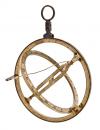  |
A UNIVERSAL EQUINOCTIAL RING DIAL BY DOLLOND, LONDON, CIRCA 1800
in lacquered brass, signed under the degree scale as per title, chapter ring with black-filled Roman numerals, pivoted bridge with calendar and zodiac scales and sliding gnomon, string gnomon with slotted pin sight, the rim with sliding suspension loop - 6in. (15cm.) diam
£1000-1500
|
|
 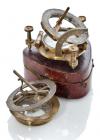 |
A POCKET COMPASS SUNDIAL BY ELLIOTT BROTHERS, CIRCA 1870
with 1½in. silvered dial signed Elliott Brothers / 440 Strand / London, mounted on lacquered brass bedplate with three levelling screws, two bubble levels, folding latitude scale and hour ring with folding gnomon, contained within plush-lined Morocco case with label on base, overall - 3½in. (9cm.) wide; together with an early 19th-century brass pocket compass sundial, unsigned and lacking case
(2)
£250-350
|
|

|
A LARGE BOXWOOD GUNTER-TYPE HORARY QUADRANT, ENGLISH, CIRCA 1760
unsigned, constructed in laminated sections and inscribed over one side with the usual degree scales and equinox dates, the shadow square with positions for five stars, plummet hole and remnant sights in the top edge - 12in. (30.5cm.) radius
Literature: Cowham, M: A Dial in your Poke, 2nd Ed., Cambridge 2011, p.32-3
£1500-2500
|
|

|
AN EARLY 19TH-CENTURY TIMING GLASS
the conjoined bulbs filled with volcanic sand between pine end-plates secured with four square section supports, one end plate inscribed '10 minutes' - 7in. (18cm.) high
£150-250
|
|

|
A DIPLEIDOSCOPE BY E.J. DENT, LONDON, CIRCA 1850
mounted on a bedplate numbered 'L791', threaded levelling, bubble level and compass box with steel needle, brass prism cap inscribed E.I. DENT'S / PATENT / MERIDIAN INSTRUMENT / 82, Strand / & 33, Cockspur St. / LONDON, contained within fitted box with glass shade in lid and wooden retainers to sides - 5in. (12.5cm.) square
£250-350
|
|

|
A RARE POCKET COMPASS SUNDIAL BY JOHN FOWLER, CIRCA 1730
constructed in engraved brass with black wax filling, folding gnomon, blued-steel needle, signed J Fowler fecit between 'III' and 'VIII', complete with lid - 2 5/8in. (6.7cm.) diam
John Fowler worked between 1721 and 1750 from The Globe, Sweeting's Alley by the Royal Exchange, London, and specialised in sundials and compasses
£250-400
|
|
 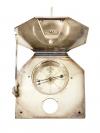   |
A RARE SILVER-PLATED BRASS INCLINING DIAL BY J. SISSON, LONDON, CIRCA 1740
the 4½in. diameter dial with sprung folding gnomon signed I Sifson / LONDON, the hours running IIII-XII-VIII, inner degree scale running 140º-0-140º, hinged by 'XII' to baseplate with hinged latitude arm, level recess, and inset 2¼in. glazed compass with blued-steel needle, contained in fitted plush-lined Morocco leather case - 5¼in. (13.3cm.) square
Exhibited: The Clockwork of the Heavens, Asprey & Company, London, November 1973, item 55 (Private Collection)
Jonathan Sisson (1690-1749) worked from the Strand and was father of Jeremiah Sisson who continued between 1749-1783. Both signed their instruments 'J. Sisson' and distinguishing between them has long been debated without conclusion.
£3000-4000
|
|
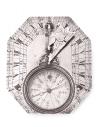 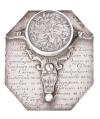 |
A SILVER BUTTERFIELD DIAL, CIRCA 1740
of usual form, with folding bird gnomon, glazed compass compartment with blued compass needle signed on the reverse BUTTERFIELD À PARIS with latitude table to European cities and foliate scrollwork behind compass and French silver marks - 3in. (7.5cm.) wide
£1200-1500
|
|
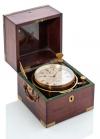 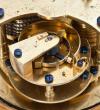 |
CHARLES CUMMINS, LONDON, A FINE 8-DAY MARINE CHRONOMETER, No. 1051/im, CIRCA 1845
the 4in. silvered dial signed and numbered Charles Cummins near the India House, London. 1051/im, radial champlevé Roman numerals, blued steel hands, up-down and seconds dials, 2-frame brass movement with reverse fusee and chain, Harrison's maintaining power, spotted plates, Earnshaw-type footed spring detent escapement, bi-metallic compensation balance with wedge-shaped heat compensation weights and meantime adjustment nuts, free-sprung blued steel helical balance spring, contained within counter-weighted gimballed brass bowl within three-tier brass-bound mahogany box with brass drop handles
- 8 x 7¼ x 7¼in. (20.3 x 18.5 x 18.5cm.)
£2000-3000
|
|
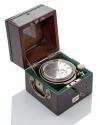 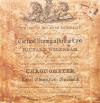 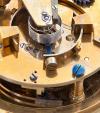 |
RICHARD WIDENHAM, EAST STREET, LONDON, A SMALL TWO-DAY MARINE CHRONOMETER WITH AUXILIARY COMPENSATION, No. 1160, CIRCA 1835
signed and numbered on the 3in. silvered dial Widenham London 1160, radial champlevé Roman numerals, gold hour and minute hands, three quarter plate brass movement with separate plate to secure the spring barrel, fusee and chain, Harrison's maintaining power, bi-metallic "Z" balance with wedge-shaped temperature weights and meantime adjustment screws, two screws on each arm for auxiliary compensation, Earnshaw-type spring footed detent escapement, free-sprung silver-coloured helical balance spring, diamond endstone, contained within silvered gimbal-mounted bowl within three-tier counter-numbered box with full maker's trade label lining the lid, original key and silvered drop handles, approximately - 5in. (12.7cm.) square
£1800-2500
|
|
 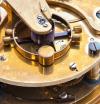 |
D. McGREGOR & Co., GLASGOW & GREENOCK, A TWO-DAY MARINE CHRONOMETER WITH MERCER'S AUXILIARY COMPENSATION BALANCE, No. J/5846, CIRCA 1875
the 4in. silvered dial signed D. McGregor & Co., Makers to the Admiralty, Glasgow & Greenock, and numbered in the subsidiary seconds dial J/5846, radial champlevé Roman numerals, large subsidiary seconds, up-and-down dial, gold hour and minute hands, spotted brass plates with separate bridge for the spring barrel, fusee and chain, bi-metallic balance with Mercer's auxiliary compensation, free-sprung blued steel helical spring, Earnshaw-type spring footed detent escapement, diamond endstone, the plates and bowl punch-numbered 6253, gimbal mounted within three-tier mahogany box with ivorine maker's plate counter numbered J/5846 with brass stringing to front and inset handles - 7½in. (19cm.) square
£2000-3000
|
|
 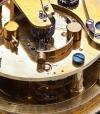 |
[HENRY] FRODSHAM, LIVERPOOL, A TWO-DAY MARINE CHRONOMETER, No. 2413, CIRCA 1840
the 4in. silvered dial signed, inscribed and numbered Frodsham, Succefsor to / Parkinson. & Frodsham. / MAKER TO THE ADMIRALTY / South Castle St. Liverpool, 2413 [one number obliterated above], radial champlevé Roman numerals, gold hour and minute hands, spotted brass plates with separate bridge for the spring barrel, fusee and chain, bi-metallic "Z-type" balance with cylindrical temperature weights, rating nuts and auxiliary compensation, Earnshaw-type footed spring detent escapement, counter numbered bowl, gimbal-mounted within three tier brass-bound mahogany box with signature plaque (later) and inset handles, approximately - 7½in. (19cm.) square
£1200-1800
|
|

|
WEMPE, HAMBURG, A TWO-DAY MARINE CHRONOMETER, No. 8218, CIRCA 1968
the 4in. frosted dial signed Chronometerwerke, Wempe, Hamburg, and numbered 8218, upright black Arabic numerals, subsidiary seconds and up-and-down dials, blued steel hands, matte silver metal plates, reverse fusee and chain, free-sprung silver-coloured helical balance spring, integral balance with four cylindrical temperature compensation weights, Earnshaw-type footed spring detent escapement within counter-weighted patinated plastic bowl and gimballed within two-tier mahogany box with bevelled glass top, original tipsy key, maker's plaque bearing counter number, approx. - 7in. (18cm.) square
£500-800
|
|

|
JOSEPH SEWELL, LIVERPOOL, A TWO-DAY MARINE CHRONOMETER, No. 4804, CIRCA 1890
the 4in. silvered dial signed Joseph Sewill, 61 So-Castle Street, Liverpool, Maker to the Admiralty / 4804 , champlevé radial Roman numerals, subsidiary seconds and up-and-down dial, gold hour and minute hands, fusee and chain, free-sprung blued steel helical balance spring, diamond endstone, bimetallic balance with two cylindrical heat compensation weights, meantime adjustment nuts, Earnshaw footed spring detent escapement, plain plates, gimbal mounted within three-tier mahogany box with drop handles and original tipsy winding key and brass plate engraved Bury & District Federation of Homing Societies, approximately - 7½in. (19cm.) square
£300-500
|
|
  |
A TWO-DAY RUSSIAN MARINE CHRONOMETER,
20TH-CENTURY
the 4in. frosted dial signed in Cyrillic and numbered 06191, upright black Arabic numerals, large subsidiary seconds, up-and-down dial, striped gilt plates, reverse fusee bi-metallic integral balance with four heat compensation weights and meantime adjustment nuts, free-sprung silver-metal helical balance spring, Earnshaw-type footed spring detent escapement, counter numbered plates, gimbal-mounted within three-tier box with Cyrillic label and drop handles - 8in. (20cm.) square
£600-800
|
|
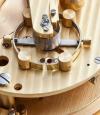  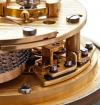 |
A TWO-DAY RUSSIAN MARINE CHRONOMETER,
20TH-CENTURY
the 4in. frosted dial signed and numbered NMEHM KNPOBA 8261, upright Arabic numerals, subsidiary seconds and up-and-down dial, striped gilt plates, reverse fusee and chain, maintaining power, bi-metallic integral balance with four cylindrical heat compensation weights, free-sprung silver-metal helical balance spring, Earnshaw-type footed spring detent escapement, mechanism intended for electrical impulse connected to the escapement via an extra wheel mounted above the fourth wheel on its pinion, plates numbered 21854, gimbal-mounted within three-tier box with Cyrillic label and drop handles - 8in. (20cm.) square, contained within plush-guard box of issue, approximately - 10in. (25.5cm.) square
£600-800
| Models | |
|
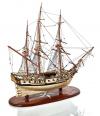 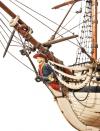 |
Ø A WOOD AND IVORY PRISONER-OF-WAR-STYLE MODEL OF A WARSHIP, LATE 19TH-CENTURY
the planked and pinned hull with ebonised wale, gunports with guns, chain plates with dead eyes, well-carved full-length polychrome figurehead of a merchant in hat, stern carvings, the decks with fittings and armament, bound masts, standing and running rigging, mounted on a wooden display base with marquetry compass rose at centre - 20½ x 22in. (52 x 56cm.)
£800-1200
|
|

|
A WELL PRESENTED AND FINELY DETAILED ½' TO 1" SCALE OF THE ALDEBURGH SPRAT BOAT OSSIE [1893]
modelled by R. Phillips as in working practice, in cherry and spruce woods, with varnished interior, raised masts with sails and mounted on a wooden stand with oars and nameplate, overall measurements - 11½ x 12in. (29 x 30.5cm.)
£250-350
|
|

|
A STYLISED BONE MODEL OF A MAN O'WAR, POSSIBLY PORTUGUESE, CIRCA 1860
depicting a ram-bowed battleship with simple fittings including ventilators and funnel, set atop a decorative carved mount within later case, cased measurements - 10¼ x 13 x 6in. (26 x 33 x 15cm.)
£400-600
|
|

|
A WELL-PRESENTED MODEL OF THE BARQUE MANILA, CIRCA 1880
with carved hull finished in grey and pink with varnished topsides, scored decks deck winch, companion ways, covered hatches, ventilation, deck house with fitted boats over, belaying rails, bilge pump, gratings, helm and other details, masts with yard and foot ropes, standing and running rigging, mounted on two brass supports within glazed wooden case overall - 11 x 13 x 5¼in. (28 x 33 x 13.5cm.)
£500-800
|
|

